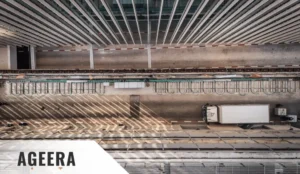Load Shifting and Peak Shaving Explained
As energy prices fluctuate and grid demands grow increasingly complex, two concepts have become essential to modern energy strategy — load shifting and peak shaving. Both are critical tools for reducing costs, improving efficiency, and stabilizing operations. With AGEERA’s advanced Energy Management and Battery Storage Platform, businesses can automate these processes through intelligent control, transforming energy from a passive expense into an active source of profit.
Understanding Load Shifting
Load shifting refers to the practice of moving energy consumption from high-cost periods to times when electricity prices or demand are lower. For example, a manufacturing plant might charge its battery system overnight when tariffs are low and then use that stored power during the day when rates spike.
This not only reduces the total cost of energy but also balances demand across the grid. When powered by AI-driven forecasting, as in AGEERA’s Energy Management Platform, load shifting becomes a fully automated process. The system continuously analyzes energy prices, production schedules, and grid signals to decide when to charge, discharge, or draw from the grid — in real time.
What Is Peak Shaving?
While load shifting focuses on timing, peak shaving is about limiting the intensity of consumption during high-demand moments. Many utilities apply extra charges — called demand charges — based on a facility’s highest energy use within a billing cycle. By using stored power during these spikes, companies can reduce their “peak” and dramatically lower those costs.
AGEERA’s Battery Energy Storage System (BESS) detects when a facility is approaching a load threshold and instantly discharges stored energy to flatten the spike. The result: smoother energy curves, lower bills, and reduced strain on both the site and the grid.
Why It Matters for Business
For industrial facilities, commercial centers, and data-driven operations, electricity is one of the largest recurring costs. Tariff changes, grid volatility, and fluctuating renewable generation all create unpredictability. Load shifting and peak shaving provide stability — allowing companies to predict and manage their energy expenses with precision.
AGEERA’s platform uses AI forecasting and machine learning to identify usage trends specific to each client. This means energy strategies are no longer static — they evolve automatically with production patterns, occupancy, and even weather conditions.
Practical Example: The Carmel Industrial Park
At the Carmel Industrial Park, AGEERA implemented a smart microgrid that combines rooftop solar generation with advanced battery storage. The system automatically charges from excess solar production during midday, then discharges during peak evening tariffs. Over time, the site reduced its utility costs by leveraging both load shifting and peak shaving in tandem — maximizing savings and energy independence.
This kind of real-world success story proves that energy optimization is not just theoretical — it’s measurable and repeatable across industries.
The Role of AI in Optimization
Both load shifting and peak shaving rely on accurate forecasting. AI makes this possible by continuously analyzing real-time data — tariffs, weather patterns, equipment loads, and grid behavior. The AGEERA EMS then executes the best operational scenario automatically, adjusting second by second as conditions change.
Instead of following a fixed schedule, the platform learns and adapts. For example, it can predict tomorrow’s solar production, match it to forecasted demand, and prepare the batteries to ensure optimal cost reduction. This adaptability turns energy management into a living, intelligent system rather than a static routine.
Financial and Operational Benefits
- Reduced utility bills: Lower both energy and demand charges through automation.
- Improved equipment lifespan: Smooth energy usage reduces wear on electrical systems.
- Better use of renewables: Store solar or wind power for peak-hour discharge.
- Predictable budgeting: Avoid the volatility of time-of-use pricing.
- Grid support and revenue: Participate in flexibility programs and Virtual Power Plant (VPP) networks.
Load Shifting vs. Peak Shaving: The Key Difference
Although the two strategies work hand in hand, they serve different purposes. Load shifting optimizes when you use energy; peak shaving optimizes how much you draw at any given time. A well-designed energy system, like those managed by AGEERA, integrates both seamlessly — using AI to decide which approach provides the greatest benefit moment by moment.
Integrating With Renewable Energy
Load shifting becomes even more powerful when paired with renewable generation. Excess solar energy can be stored during daylight and released in the evening when consumption rises. This increases self-consumption, reduces dependency on fossil-based grid power, and enhances sustainability metrics. Projects like those showcased on the AGEERA Projects page highlight how clean energy and smart storage create long-term economic and environmental value.
Environmental and ESG Value
Beyond cost savings, load shifting and peak shaving contribute directly to sustainability goals. By balancing demand and reducing strain on the grid, these methods lower emissions and support renewable integration. Companies leveraging such systems can demonstrate tangible ESG progress — less waste, lower carbon footprints, and smarter use of clean energy assets.
Key Takeaway: Intelligence Equals Efficiency
Energy optimization is no longer about manual control — it’s about predictive precision. With AGEERA’s AI-based management system, load shifting and peak shaving happen automatically, invisibly, and profitably. Businesses gain cost stability, improved sustainability, and operational peace of mind — all while contributing to a more flexible and resilient power grid.
Frequently Asked Questions
Can any business benefit from load shifting?
Yes. From small commercial buildings to large industrial complexes, any site with variable demand can benefit from time-based energy optimization.
Do I need solar panels for this to work?
No. While renewables enhance results, load shifting and peak shaving also deliver strong returns using only grid electricity and battery storage.
How long does installation take?
Most systems are designed, installed, and commissioned within 4–6 months, depending on site size and energy complexity.
What level of automation does AGEERA provide?
The platform handles all forecasting, scheduling, and dispatch automatically, with full user oversight through a cloud dashboard.
Can I monitor savings in real time?
Absolutely. The system displays consumption data, storage performance, and financial results live through the EMS interface.
Summary
Load shifting and peak shaving are no longer niche techniques — they’re essential to modern energy management. With AGEERA’s AI-powered platform, organizations can reduce costs, stabilize operations, and actively participate in the new smart grid economy. Explore AGEERA’s real-world projects to see how intelligent storage turns data into savings and sustainability.






